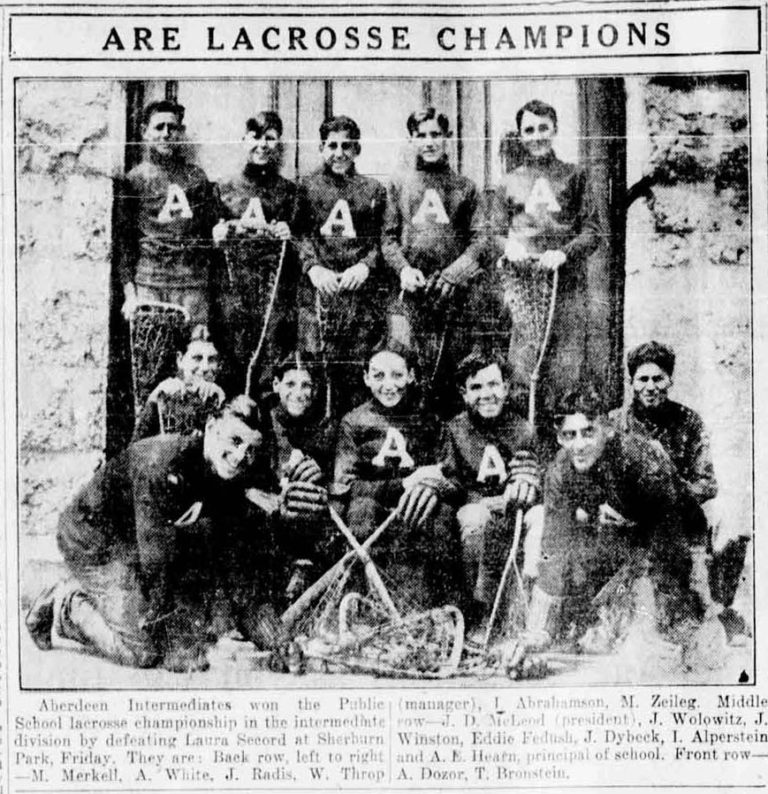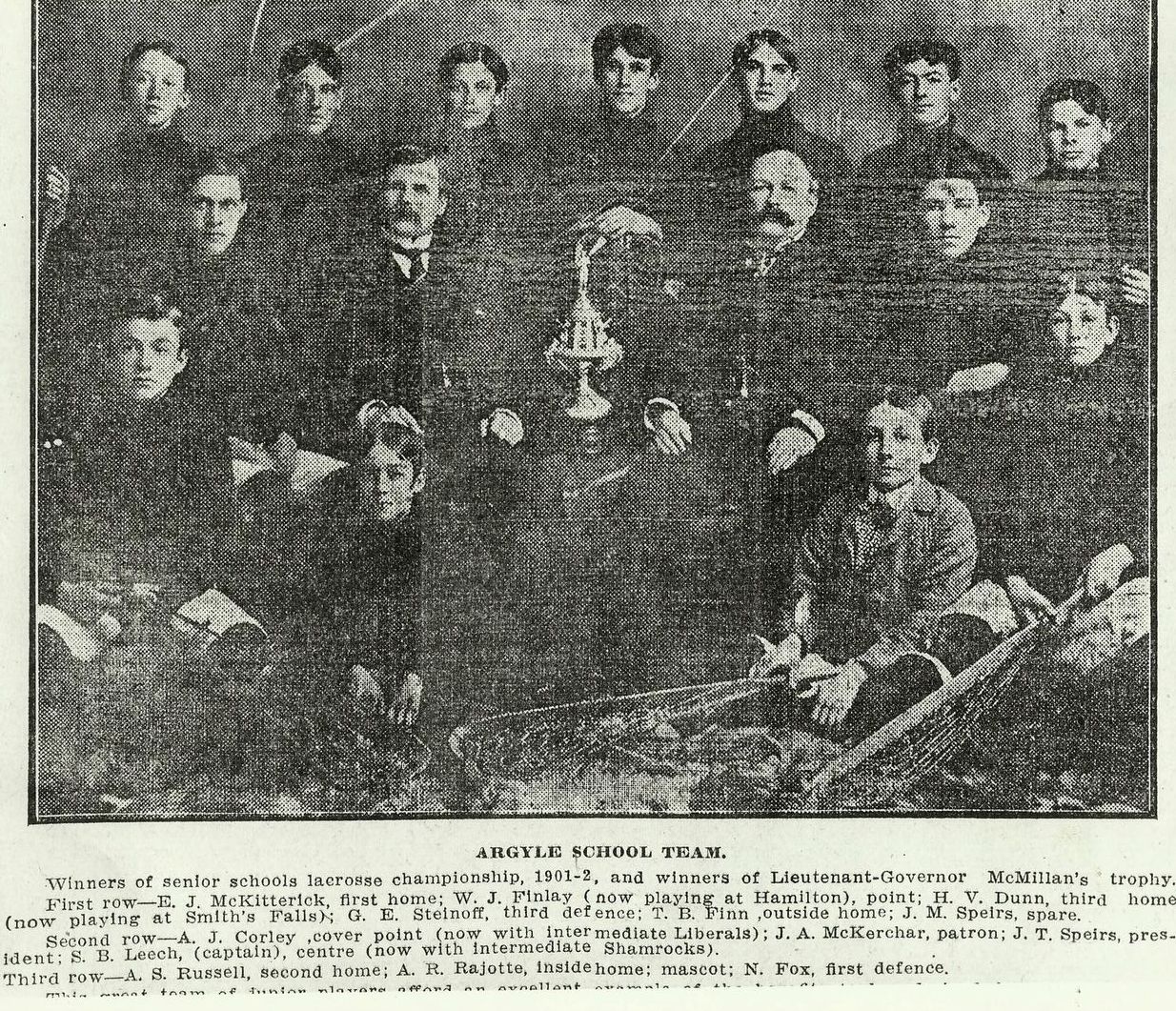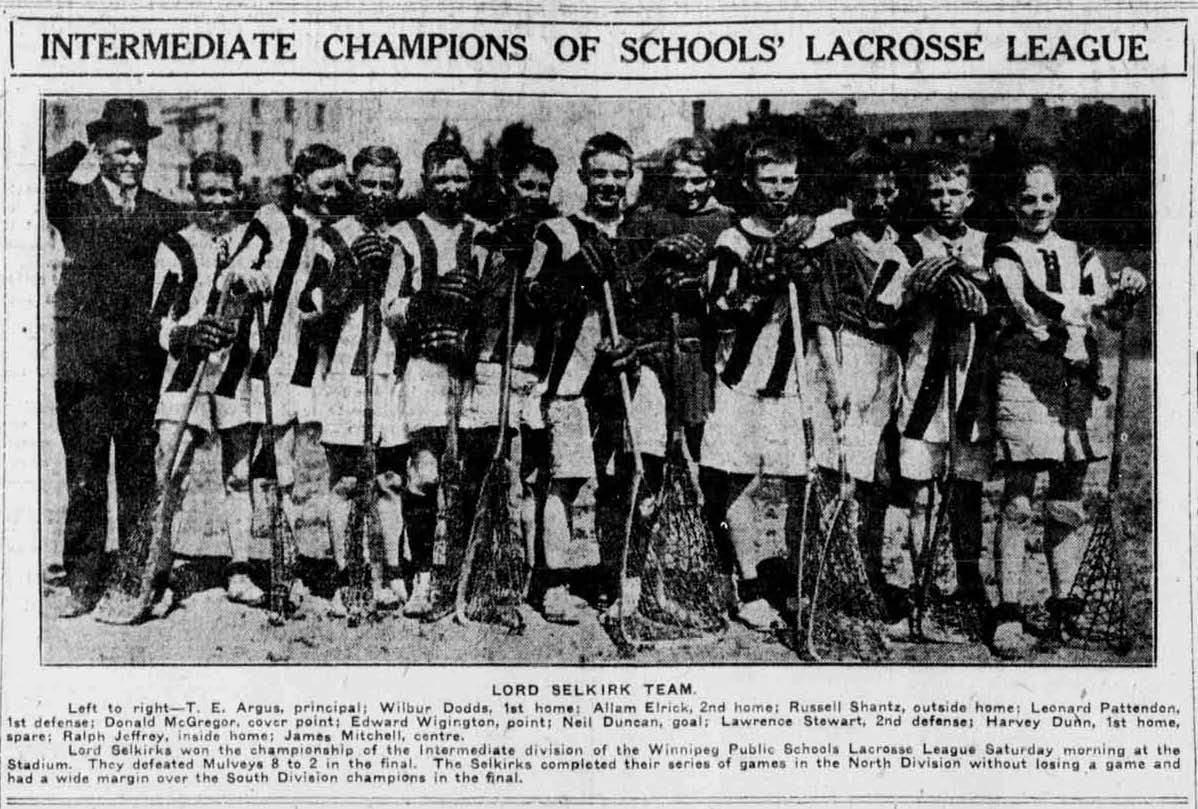Early School lacrosse ...
Decade: 1900s-1920s
Theme: Early school lacrosse
Amateur leaders believed that sports, including lacrosse, could contribute to both the physical and social betterment of participants. In this climate, it is not surprising that lacrosse was introduced into the school system in 1901 when the Winnipeg school board created the first local school leagues. This development was due in part to the popularity of the sport in the city, but also reflected the changing emphasis placed upon physical education in Manitoba schools.
As educators' thinking evolved in the late-nineteenth century, schools became places that did more than teach the basics of knowledge (reading, writing, mathematics) and increased emphasis was placed on the teaching of non-traditional academic subjects such as music, movement, and art for girls and physical training for boys. Influenced by developments elsewhere in the country, primarily in Ontario, the Manitoba school system adopted a curriculum of physical education in the late-1890s. At the time these activities consisted primarily of military-style drill for boys (and limited calisthenics for girls) with discipline to be, as historian Morris Mott notes, "the main benefit to be derived from periods of formal calisthenics and drill."[1] This curriculum expanded to include games in the first decades of the twentieth century as educators developed a new appreciation of the importance of play - as long as such recreation continued to be "rational" and purposeful.
This increased emphasis on physical activity in schools had a number of outcomes, one of which was the creation of a number of school sports leagues in Winnipeg, although playing opportunities were primarily available only to boys. The School Lacrosse League was spearheaded by Robert Smith, a long-time School Board member and lacrosse enthusiast who played for the Winnipeg Lacrosse Club. Much like their city and provincial counterparts, the School League was divided into senior, intermediate, and junior divisions. While the age restrictions varied over the years, the most common designations placed boys 13 and younger in the junior league, 14 and younger in the intermediate league, and 17 and younger in the senior league.
Games were played on Saturday mornings starting in the month of May, with almost all of the games taking place on school grounds. The league was run and organized by the principals and teachers of the district, with the latter often taking on the role of referees. Boys penalized on the field on Saturday would often be reprimanded for their misconduct at school the following Monday. In order to encourage participation in lacrosse, the School Board acquired sticks in bulk and sold them to students at half-price. At 25 cents per stick (some sources note the cost as 75 cents per stick), this purchase was still not a cheap one for the boys who played. As a result, an informal network developed where older boys who had mastered a variety of ways to keep lacrosse sticks in playing shape would pass on this knowledge to younger players.
While an entity confined within the school system whose creation was linked to changing perceptions of physical education, the School Lacrosse League also offered a developmental opportunity for the city's and province's lacrosse players. Take the case of Hall of Fame inductee Richard Henry "Dick" Buckingham. Born in Winnipeg in 1900, Buckingham was an outstanding multi-sport athlete, typical of this era. He began playing lacrosse at age 10 and would eventually play for a number of the city's prominent clubs, including the Tammany Tigers, Argonauts, and Wellingtons, and played on Canada's 1932 Olympic team, but it was in the School League that he first developed his skills. Buckingham was a member of the Norquay School team that won three consecutive McMillan Trophies as senior champions from 1914-16.
Despite examples such as Buckingham, contemporary accounts lamented the lack of connection between the school leagues and the city's waxing and waning amateur lacrosse leagues discussed in the 1880s-1910s section. As one local paper opined in 1911:
For many years Winnipeg has been noted for its well conducted Schools Lacrosse league and the class of play put up by the youngsters amazed the fans who claimed a great future for lacrosse in Winnipeg, as the fast growing lads were expected to show improvement that would soon fit them for senior company. But such was not the case. Few of the boys stuck with the game after they left school and gradually there was no new material developed to fill the positions of the seniors who gradually retired from the game, so that senior lacrosse started to topple until last year it was practically dead... But there was good cause for the boys throwing away their sticks and getting into other sports, as of recent years there has not been a junior league for them to go into and adjust to play in faster company.
Of the schools that participated in the Winnipeg School Lacrosse League in the first three decades of the twentieth century, the most noteworthy included Norquay School and Machray School. Of the 25 senior champions that were awarded the McMillan Trophy, Norquay won six times with a three-year winning streak between 1914 and 1916, while Machray won five times with a four-year winning streak between 1920 and 1923. In 1907, Victoria School became the only school to win the league championships at each level in a single year.
It is also worth noting that school lacrosse was not only popular in Winnipeg: some smaller towns also had thriving school leagues at the time, such as Neepawa, where six schools participated.
Two explanations have been offered for lacrosse being pulled from Winnipeg schools in 1929. On one hand it was felt that the sport, which had been intended to improve the general behaviour and attitude of those who played it, was becoming too physical and violent on the field. An alternate explanation is that lacrosse was becoming too expensive. The School Board had begun to lose too much money on the sale of lacrosse sticks as the price for equipment continued to increase while the number of boys purchasing sticks decreased. Although the end of the School Lacrosse League would hurt the development of the sport in the city and the province, the next decade would bring about a dramatic restructuring of the game
Significant achievements
Winnipeg Schools Lacrosse League champions[2]
| Senior (McMillan Trophy) | Intermediate (Intermediate Shield) | Intermediate (Day Trophy) | Junior (Arbuthnot Trophy) | |
| 1901 | Argyle School | Carlton School | ||
| 1902 | Argyle School | Somerset School | ||
| 1903 | Isbister School | Victoria School | ||
| 1904 | Victoria School | Mulvey School | ||
| 1905 | Argyle School | [no record] | ||
| 1906 | Victoria School | Alexandra School | ||
| 1907 | Victoria School | Victoria School | Victoria School | |
| 1908 | Alexandra School | Gladstone & Somerset Schools (tie) | Victoria School | |
| 1909 | Norquay School | Wellington School | Machray School | |
| 1910 | Victoria School | Pinkham School | Norquay School | |
| 1911 | Mulvey School | Norquay School | Isbister School | Machray School |
| 1912 | Gladstone School | Aberdeen School | John M. King School | [no record] |
| 1913 | Mulvey School | Strathcona School | [no record] | Greenway School |
| 1914 | Norquay School | Machray School | [no record] | Lord Roberts School |
| 1915 | Norquay School | Greenway School | Machray School | Mulvey School |
| 1916 | Norquay School | Mulvey School | Machray School | Aberdeen School |
| 1917 | Mulvey School | Principal Sparling School | John M. King School | |
| 1918 | Norquay School | Aberdeen School | Machray School | |
| 1919 | Norquay School | Machray School | Norquay School | |
| 1920 | Machray School | Aberdeen School | Mulvey School | |
| 1921 | Machray School | Principal Sparling School | [no record] | |
| 1922 | Machray School | Lord Selkirk School | Machray School | |
| 1923 | Machray School | Wellington School | Greenway School | |
| 1924 | Alexandra School | Mulvey School | Principal Sparling School | |
| 1925 | Greenway School | Machray School | Greenway School | |
| 1926 | Machray School | Aberdeen School | Machray School | |
| 1927 | [no record] | Alexandra School | Machray School | |
| 1928 | [no record] | Isaac Brock School | Lord Selkirk School |
Learning lacrosse
The origins of lacrosse and Indigenous culture
Despite its presumed origins as an Indigenous pastime, the modern sport of lacrosse was the creation of urban Anglophone professionals in mid-nineteenth century Canada. The sport's origins are associated most prominently with the Montreal dentist, George Beers, who played for the Montreal Lacrosse Club in the 1850s-1860s and first codified the rules of the modern game in 1860. He aggressively promoted lacrosse, organized associations, prepared training manuals, organized tours to the US and UK to demonstrate the sport, and was largely responsible for declaring lacrosse Canada's "national game" in 1867. This is not to say that lacrosse is not associated with Indigenous practices. Situated in Montreal, Beers was familiar with the stick-and-ball games of the Akwesasne and Kahnawake peoples, and elements of games such as Baggataway and Tewaarathon were incorporated into the rules of lacrosse. But the sport was infused with distinctly Euro-canadian values. In appropriating and transforming aboriginal cultural practices and associating them with a French name ("la crosse" being symbolic of the stick), organizers such as Beers were, according to historian Gillian Poulter, combining native and habitant cultures to create through sport what they believed was a unique "native" Canadian culture.[4]
Hall of Fame inductees
Richard Henry (Dick) Buckingham
References
[1] Morris Mott, "Confronting 'Modern' Problems Through Play: The Beginning of Physical Education in Manitoba's Public Schools, 1900-1915," in Nancy M. Sheehan, J. Donald Wilson, and David C. Jones, (Eds.), Schools in the West: Essays in Canadian Educational History (Calgary, Detselig Enterprises Ltd, 1986), p. 61.
[2] Ernie O'Dowda, "Lacrosse in the Winnipeg School System, 1901-1928," Manitoba Lacrosse Association, undated.
[3] Western School Journal, 1933, p. 330, cited in Mott, "Confronting 'Modern' Problems Through Play."
[4] Gillian Poulter, Becoming Native in a Foreign Land: Sport, Visual Culture, and Identity in Montreal, 1840-1885 (Vancouver: UBC Press, 2010).





